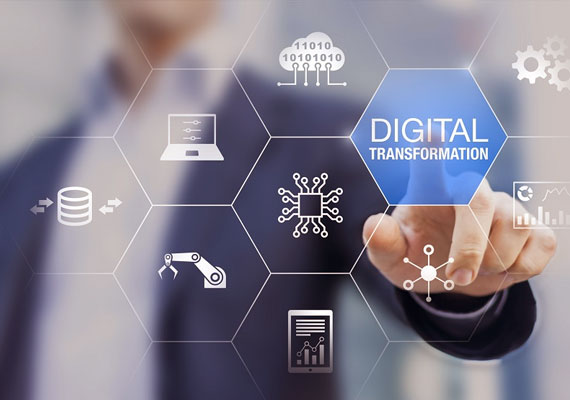Digital Transformation
What is Digital Transformation?
As digital transformation looks different in every company, so digital transformation can be defined as the
integration of digital technology into all areas of a business resulting in
fundamental changes to how businesses operate and how they deliver value to customers.
Digital Transformation aims to improve business results by adopting modern digital technologies. It
emphasizes three pillars, leveraging technology to enhance business capabilities, building operational
efficiencies, and continuously improving customer experience.

Business Process Automation
Business Process Automation is defined as the automation of complex business processes and functions beyond conventional data manipulation and record-keeping activities, using software to automate, repeatable, multistep business transactions.

Cultural Transformation
Cultural Transformation is a shift that can take place throughout an entire organization or in individual departments and teams. A successful transformation requires full engagement and buy-in from all levels of leadership throughout the organization.

Domain Transformation
Domain Transformation means transcending traditional boundaries currently facing a brand’s markets and possibilities. The potential for domain transformation exists in many industries and is driven using technologies like artificial intelligence, and new types of mobile and wearable technology.

Business Model Transformation
Business Model Transformation is the change in business strategy that focuses on changing a business’s core goals and infrastructure. It is centered around the business and go-to-market models helping drive the business and operating models to change which is required to achieve an organization’s strategic visions.

Cloud Transformation
The cloud transformation process helps organizations mitigate information systems to cloud computing environments. It involves the entire process of transitioning business data, applications, infrastructure, and other dependent hardware and software to the cloud.
 Identify and Measure Business Goals
Identify and Measure Business Goals
The most successful digital transformation objectives include key performance indicators (KPIs) that can be monitored as they are attained, assisting you in defending the effort and investment of all parties.
 Build on Your Strength
Build on Your Strength
Think about your company's current strengths, including your client base, successful products, and the values your brand has come to stand for when contemplating a digital transformation project. Make certain that no existing value is being erased.
 Establish New Operational Policies
Establish New Operational Policies
Develop operational policies with departments and teams that will take advantage of new technology, benefit employees, and increase productivity. This frequently necessitates a culture shift and a continuous instructional effort within the firm.
 Establish an Iterative Transformation Process
Establish an Iterative Transformation Process
An incremental approach to digital transformation is more likely to be successful than a "big bang" approach. A flexible technique will enable you to quickly assimilate new information and adjust to changing conditions.
 Consider a Digital Transformation Framework
Consider a Digital Transformation Framework
By starting with a well-known structure, you may be sure that you won't overlook crucial phases or make the same errors that other companies have. If your management team has no prior experience with digital transformation, this might be very crucial. Of course, it's critical to modify frameworks to meet the unique needs and objectives of your firm
Digital Transformation Use Cases
- Manufacturing: Predictive maintenance and process optimization made possible by the Internet of Things (IoT) may boost productivity and profitability while decreasing scrap and machine downtime.
- Retail: For better consumer experiences, digital technology leverages digital platforms, channels, and devices.
- Healthcare: A variety of digital capabilities are being introduced by the healthcare sector, which may adjust medical services and make them more patient-centric and value-based.
- Banking: Financial institutions are moving away from the conventional operating model of branch offices where bankers provided in-person service and toward a variety of digital models.